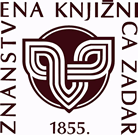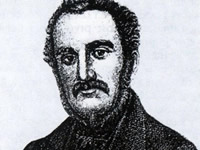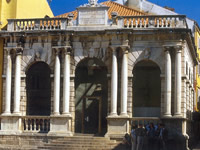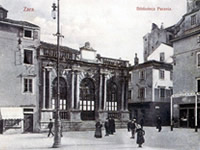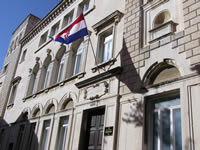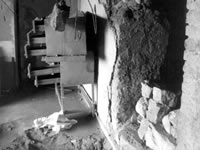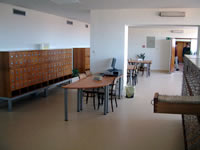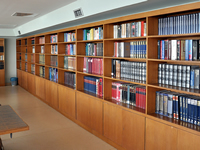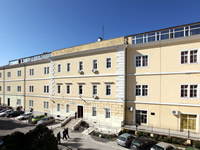Zadar has been the political centre of Dalmatia for centuries, but it has also been an important centre of literacy and culture. The rich historical memory of the city and Dalmatia has been preserved in the library holdings of one of the largest Croatian libraries Znanstvena knjižnica Zadar – the Research Library of Zadar.
The Library was founded in 1855, but it actually started working on 18 August 1857. It was named Biblioteca Comunale Paravia (Communal Library Paravia) in honour of its first donator and founder Pietro Alessandro Paravia (1797 – 1857), of Zadar by birth and a university professor in Turin.
On the occasion of his visit to Zadar in 1850, Paravia decided to donate a rich collection of books to his hometown, a collection that was supposed to serve as the nucleus of the future public library. At his request the Municipality assigned to the Library the City Loggia (Picts. 1 and 2) in the central town square. In the first year the Library holdings consisted of 18 000 volumes of library materials, which could be used, according to the Rules of the Library, on the premises only.
Besides the materials donated by Paravia, some books were purchased by the funds of the Municipality, and a significant part came to the Library as gifts from individual Zadar families. Thus by the start of World War II the Library holdings were enriched with several private collections of books by well-known Zadar families: Bianchi, Bernardi, Vuleta, Strmić, Ponte, Sanfermo, Artale, Tommaseo, Maddalena, Nagy, Ferrari-Cupilli, Battara, Negovetić, Pappafava ...
The library holdings grew from year to year, and in 1913 it consisted of 40 000 and in 1932 of approximately 60 000 library items. The Library remained in the City Loggia until 1938 when it was moved to a purpose-built wing of a new town hall (Pict. 3). The library holdings would probably have been even richer but for restrictive policy in acquisition during the period of Italian administration. Namely, books and periodicals printed in Croatian were not acquired for the Library, so that until the end of World War II the Library did not possess the greatest and oldest Zadar newspapers: Narodni list, Katolička Dalmacija, Hrvatska kruna, Hrvatska, Zviezda, Iskra, Lovor and others.
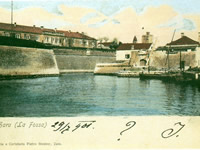
4. Foša and the Austrian barracks, the seat of the Library since 1972 – its appearance at the turn of the century
In 1941, the Italian administration of the Library took to Italy, ‘to safety’ 5 100 most valuable library items, among them several rare books as Judita (1521), newspapers (Kraglski Dalmatin, 1806-1810), all incunables, manuscripts and parchments. These remained in Italy until 1961, when they were returned to Zadar, following the peace treaty between Italy and Yugoslavia. During the horrible destruction of Zadar from 1943 to 1944 the Library ceased working. The library building suffered damage, but it was spared the fate that befell almost the whole town, when the largest public library in Zadar and Dalmatia, the library of Zadar Grammar School was destroyed. Biblioteca Paravia was re-opened to the public access on 14 October 1945, under a new name – Narodna biblioteka. In addition to the Research Department, consisting mainly of the Paravia holdings, a new Lending Department was established with a modest stock of 992 volumes. The latter developed fast thanks to the books salvaged from the ruins in the city. In early 1949 Narodna biblioteka was divided into two independent institutions: The Research Department became Naučna biblioteka and it continued its independent activity in the same premises, and the Lending Department became Gradska biblioteka (City Library), which was situated in the House of Culture (Rector’s Palace).
The Research Library came under the authority of the Government Committee of the Republic of Croatia for scholarly institutions, universities and colleges. In 1949 they decided to grant the Library a Croatian deposit copy of all printed matter. Library holdings were also enriched with private libraries of distinguished citizens: academician Ivan Brčić, the Modrić family, Jakov Čuka, part of the Marasović library of Skradin, the books of the Erco, Marcelić-Miletić and other families. The rich holdings of the Research Library were one of the reasons for the foundation of the Faculty of Arts in Zadar in 1956. In 1962 the Council for Culture of (the People’s Committee of the Community of) Zadar chose the Research library as central library of the Community of Zadar, and in 1976 the Council for Croatian libraries entrusted the Research Library with the duty of central service for special libraries in colleges, scholarly and cultural institutions, as well as libraries of the cathedral chapter, of the Roman catholic seminary ‘Zmajević’, of the monasteries of St. Michael, St. Francis, St. Paul the Hermit on the islet of Školjić that are important as monuments of culture.
Due to extensive growth of the library holdings as well as the influx of students in the sixties, Zadar town authorities decided to move the Library to the adapted building of the former Austrian barrack built in 1848. The Library moved into new premises on 4 January 1972 (Pict. 4). The holdings continued to grow rapidly, mostly thanks to deposit copy (75%), donations, purchase and exchange. Because of its general scholarly character, in 1990 the Research Library became an associated member of the University of Split, and in 1992 it acquired its present name ‘Znanstvena knjižnica’. In the Homeland war the Library was damaged on two occasions. First in October 1991, when it was hit by approximately ten cannon shells, and in May 1992. Complete computer equipment was destroyed, the librarians’ work area (Pict. 5) and the materials that happened to be there, as well as the roof of the building. Complete war damage was estimated at 200 000 €. In spite of the danger and damages to the building, the Library was constantly at the service to its users during the whole war. The Library was awarded the Prize of the City of Zadar for ‘outstanding success in the fields of science and culture’.
The Library follows contemporary trends in the development of the profession and it makes efforts to provide its users with faster and better searching facilities by means of electronic catalogue since September 2000. In addition to online catalogue, users can choose from the alphabetical, classified and specialized catalogues. By means of the Internet it is possible to search libraries in Croatia and abroad. Since 1994 the Library has regularly organized an annual exhibition ‘Publishing in the Zadar area’, which, by the number and profusion of titles, testifies to the lively publishing activity in this area.
The Research Library in Zadar, as a keeper of rich cultural heritage containing mediaeval manuscripts, the incunables and the first prints of Zadar and Croatian humanists, and other rare and valuable materials, attempts to offer to its users all library and information services and to contribute to the three-thousand-year existence of Zadar, to the County and to Croatia as a part of the European culture.
